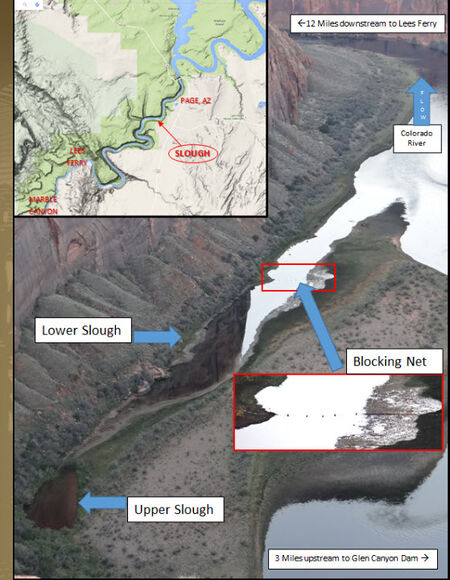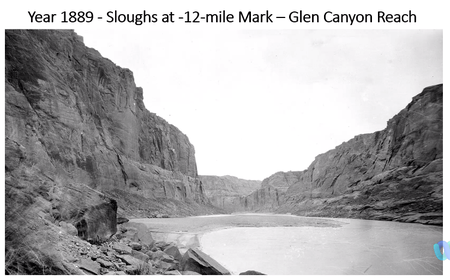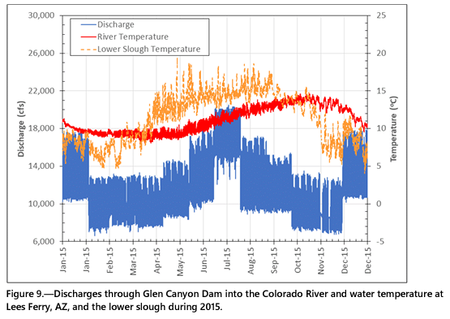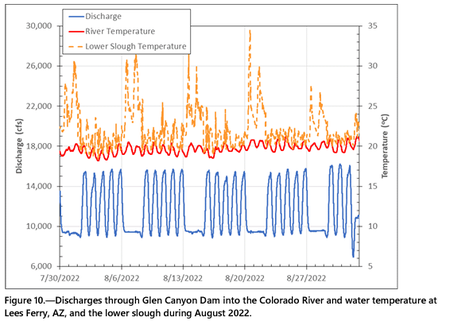|
I wanted to follow up on yesterday’s discussion about tiger salamander in the -12L Slough and elsewhere in the Glen Canyon reach, and request access to some of the data we discussed.
I was quite amazed when, during a riparian restoration project at Leopard Frog Marsh (-9L) in March 2015, I first detected and photographed a large salamander at -9L Leopard Frog Marsh. It was, for me, a new vertebrate species in the Colorado River, and to my knowledge the only salamander ever reported from Colorado River corridor downstream from the Green River confluence. I include a picture of that individual with this email.
Upon finding that salamander, I immediately contacted the NPS at Glen Canyon and Dr. Charles Drost of the USGS to determine whether to collect it alive for genetic sampling. The advice I received was that it could be a native Ambystoma mauvortium stebbinsi and, while an interesting find, it would be best to release it, which I promptly did.
In finding it, I thought it most likely was an old individual of the widespread non-native subspecies Ambystoma mauvortium mauvortium that had escaped as a bait animal. Larval tiger salamanders used for fishing bait are called ‘water dogs’ or mud puppies. I thought this because: a) tiger salamanders can live to be 25 yr old; b) bait fishing was allowed in the tailwaters reach through the post-dam period until the 1990s; c) illegal bait fishing still likely occurs there.
I noted the fact that the individual was large and old, and that in many hundreds of hours over many years of studying and sampling backwaters in that reach and upper Grand Canyon, I had never detected salamander larvae. So, was this a real population, or just one or a few old bait bucket escapees? Further, I noted that the habitat at Leopard Frog Marsh (and also at the -12L Slough) does not contain all aspects of preferred habitat by the native salamander, which includes both wetland habitats that serve as breeding pools and upland coniferous forests that support the terrestrial life phases and traditional burrow sites.
With the discussion from yesterday’s TWG meeting, it appears that genetic information on the salamander has recently become available through the NPS. I am working with a team on a book on the hepetofauna of the Grand Canyon region, and therefore am quite interested in seeing the data from that genetics study, as I’m sure are many of our TWG colleagues. Having read through Scott Collins work on Ambystoma in Arizona, and spoken with him about northern Arizona tiger salamanders, the records we have for the native A. m. stebbinsi are from high elevation ponds and wetlands, particularly on the North Rim; however, the non-native bait subspecies, A. m. mauvortium has been widely introduced throughout the Southwest, including the northern half of the Arizona, and it may hybridize with the remaining native populations. In addition, the genetics data may tell us something about population structure, if any exists. Thus, high quality, peer-reviewed genetics data are needed to resolve the identity of the Colorado River individuals.
Also, there was mention yesterday of a 1950’s paper (perhaps by Stebbins or Lowe?) that considered there to be a potentially unique northern Arizona/southern Utah subspecies (separate from A. m. stebbinsi?). Both for the purposes of resolving this taxonomic issue and for reference for our book on Grand Canyon herpetofauna, While skeptical of that idea, I would very much appreciate the reference to that paper
Based on the information shared by Dr. Paul Grams concerning the length of time that the -12L Slough has supported stable wetlands, the absence of salamander detections at other locations on the river, and the lack of evidence of larval or young salamanders, I would be very surprised if the genetics indicated anything other than older adult A. m. mavortium or hybrid tiger salamander that has persisted there.
Thanks in advance for your attention to these requests,
Larry Stevens, PhD and Senior Ecologist Grand Canyon Wildlands Council and Director, Springs Stewardship Institute 414 North Humphries St. Flagstaff, Arizona 86001 USA (928) 440-3191 office larry@springstewardship.org SpringStewardshipInstitute.org
| 





